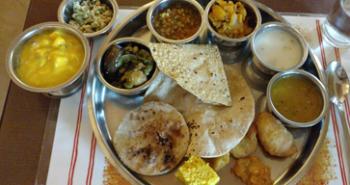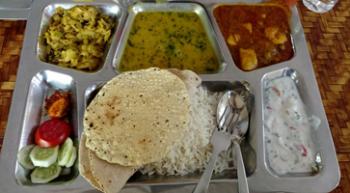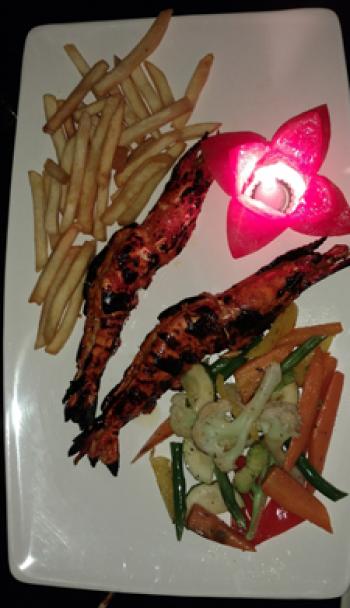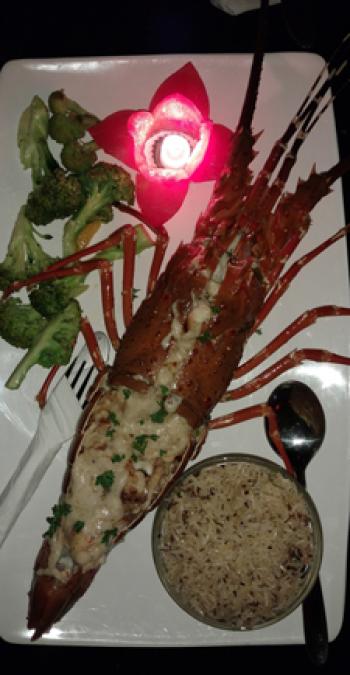Quick-reference guide to food in India
This item appears on page 34 of the December 2019 issue.
India is a huge country with many regional food specialties. Prior to a month-long trip in India that my husband and I took late in 2017 (Nov. ’19, pg. 30), I had eaten at Indian restaurants in the US but always got the same few dishes. On our trip, I began learning more vocabulary about various ingredients and types of preparation.
I admit that the following guide is oversimplified, and it’s a mishmash of terms from the regions we traveled (we did not go to the south nor east), but hopefully some background and a few of these key words will aid a first-time traveler to Delhi and environs in surviving the first week of reading menus.
Hindu is the predominant religion in India, and most Hindus are vegetarians, though some may also eat fish. Many restaurants are vegetarian only. However, there is a sizable Muslim population that eats meat, usually chicken or mutton. If you see goat or mutton on the menu, these are usually Mughul dishes, originating in the north of India, including Kashmir and beyond.
The cow is sacred to Hindus, and pork is not consumed by Muslims; neither beef nor pork is generally found on menus. Of course, several other religions are present in India as well.
You can look up menu items online through your smartphone, but we kept finding ourselves without the aid of Google. Even when I did have access to the internet, I discovered that Hindi- or Urdu-to-English translation was inadequate due to the widespread use of terms from local dialects.
In the north, many words originate from Punjab or Mughal dialects. Around Goa, where fish dishes are prevalent, names may be based on the Konkani language. I found it useful to copy a few key terms into my phone so I could quickly identify foods to try. If we were at a buffet, I’d take photos of the names of dishes to look up later at the hotel.
Once you know the ingredients you like, it’s easy to pair them with types of preparation. Here are a few key terms to know.
Murg/murgh – Chicken
Gosht – Red meat, often mutton or goat
Memana – A young animal, e.g., kid (goat) or lamb (sheep)
Samudri bhojan – Seafood
Jhinga – Shrimp/prawns
Paneer – Fresh cheese
Aloo – Potato
Palak – Spinach
Saag – Any leafy greens, such as spinach or mustard leaves
Channa – Chickpea
Baingan – A dish made with eggplant
Chaaval – Rice
PREPARATION METHODS
Tandoori – Marinated meat, usually large pieces roasted in a clay oven
Tikka – Similar to tandoori but with skewered meats
Biriyani – Mixed rice dish
Curry – Spice mixture, often served as a sauce
Korma sauce – A mild, thick curry made with meat or vegetables, spices and yogurt or cream
Momo – Tibetan steamed dumpling that looks like a Chinese dumpling
Rogan josh – Lamb curry
Pakora – Fritter
Vindaloo – Count on it being fiery hot
Bharwa – The item is stuffed with other foods
Masala – Any spice blend, such as curry
A thali lunch is the Indian version of a Japanese bento box and was one our favorite meals. It’s a lot of food, though. Thali meals are generally served on a large tray with six different dishes. If we had a thali lunch, we often felt so full, we skipped dinner.
Indian food is flavorful and complex but not light. It also isn’t bland, though spicy doesn’t always mean hot. If you’re a person who prefers bland food or if you’re looking for light options, try these:
Dal lentils – Not always light, but portions are constrained.
Vegetable biriyani – White rice with some veggies.
White rice or fried rice – With or without vegetables.
Some restaurants offer Asian foods such as stir-fried vegetables or noodles that can be milder than typical Indian foods.
BREAKFAST BUFFETS
These had me flummoxed in the beginning, as the following items would often be grouped together and I’d never know what topping went with a particular base. A helpful waiter finally straightened me out.
Paratha – Soft flatbread (like a pancake), often with very thin stuffing of mashed potatoes, dal or spinach. It may be eaten plain or with butter or sauce.
Chole bhature – Soft puffy bread (bhature) topped with chickpea curry (chole) with mint chutney.
Idli – Soft porous cake of steamed batter made from fermented lentil and rice. It’s so mild that it’s always served with a topping such as chutney, curry or sambhar (a thin lentil tamarind sauce).
SAFETY NOTE — I recommend following CDC guidelines (wwwnc.cdc.gov/travel/page/food-water-safety) for food and water while traveling.
When selecting bottled water, make sure the seal is still on the bottle, to avoid bottles refilled with tap water.
Consider treating water with chlorine dioxide tablets or a SteriPen (www.katadyn.com), an ultraviolet-light device, as studies show that bottled water in some countries varies in quality.
In general, you’re better off drinking carbonated beverages.
INGA AKSAMIT
Sausalito, CA




